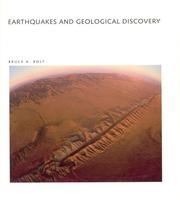| Listing 1 - 3 of 3 |
Sort by
|
Dissertation
ISBN: 9090061088 Year: 1993 Publisher: Utrecht Elinkwijk
Abstract | Keywords | Export | Availability | Bookmark
 Loading...
Loading...Choose an application
- Reference Manager
- EndNote
- RefWorks (Direct export to RefWorks)

ISBN: 0716750406 9780716750406 Year: 1993 Volume: 46 Publisher: New York Scientific American Library
Abstract | Keywords | Export | Availability | Bookmark
 Loading...
Loading...Choose an application
- Reference Manager
- EndNote
- RefWorks (Direct export to RefWorks)
Aardbevingen --- Bevingen [Aard] --- Earthquake prediction --- Earthquakes --- Prévision sismique --- Quakes (Earthquakes) --- Seismography --- Seismologie --- Seismology --- Séismes --- Séismologie --- Terre [Tremblements de ] --- Tremblements de terre --- Voorspelling van aardbevingen --- 550.348.4 --- 550.34 --- Earth disturbances --- Seismology. Earthquakes --- 550.34 Seismology. Earthquakes --- 550.348.4 Earth disturbances --- Geophysics --- Earth movements --- Natural disasters --- Prediction, Earthquake --- Geophysical prediction --- Forecasting --- Prediction --- Seismology. --- Earthquakes. --- Earthquake prediction.
Book
ISBN: 0195077857 Year: 1993 Publisher: New York Oxford university press
Abstract | Keywords | Export | Availability | Bookmark
 Loading...
Loading...Choose an application
- Reference Manager
- EndNote
- RefWorks (Direct export to RefWorks)
In Maryland, late in the spring of 1816, the snow fell brown, and blue, and even red. Brown snow fell in Hungary that year, and in the village of Taranto in southern Italy, where any snow is rare, the red and yellow snow caused great alarm. In New England, 1816 was called the Year Without aSummer. Crops failed throughout America, the price of corn and wheat soared, and farmers (lacking feed) sold off livestock, bringing about a collapse in beef and pork prices. In Western Europe, it was even worse, a major disaster, with food riots and armed groups raiding bakeries and grain markets.This turmoil followed a catastrophic volcanic eruption a year earlier on the other side of the world--the April 1815 explosion of the volcano called Tambora, on the Indonesian island of Sumbawa--a blast heard almost a thousand miles away in Sumatra.In Tales of the Earth, Charles Officer and Jake Page describe some of the great events of environmental history, from natural catastrophes such as the Tambora eruption, the Lisbon earthquake of 1755 (the greatest in recorded history), and the ice ages, to disasters such as the nuclear falloutfrom Chernobyl, acid rain, and the progressive depletion of the ozone layer. Officer and Page present much of their narrative through eye-witness accounts or through the commentary of prominent figures (in discussing the Lisbon earthquake, for instance, they recount the famous clash between Voltaireand Rousseau over the meaning of the disaster, and in discussing the Black Plague, they quote Boccaccio, whose Decameron was set during "the late deadly pestilence"). The authors provide fascinating discussions of meteorites and comets; of the demise of mammoths, mastodons, and dinosaurs; and ofgreat floods that have swept the earth.But if nature can make trouble for humanity, Officer and Page show that human activity can also make trouble for nature. They examine the depletion of natural resources (we burn coal and oil at millions of times their natural rate of production), air pollution in such major urban areas as LosAngeles and London (where the Killer Smog of 1952 caused the death of some four thousand people), and the pollution of major waterways, like the Chesapeake Bay and Lake Erie. And they explore the global impact of such phenomena as depletion of the ozone layer, acid rain, population growth, and thegreenhouse effect.Ranging from catastrophic eruptions at Santorini and Krakatoa to manmade disasters such as the mercury poisoning in Japan's Minamata Bay, Tales of the Earth will interest anyone concerned with the environment and the natural world.
614.87 --- 550.34 --- 551.21 --- 556.166 --- 52-424 --- 551.583 --- 56.017.4 --- 502.55 --- 502.56 --- 551.461.2 --- Exposure to ambient influences. Environmental hazards. Personal protection and safety --- Seismology. Earthquakes --- Vulcanicity. Vulcanism. Volcanoes. Eruptive phenomena. Eruptions --- Maximum runoff. Floods. Flood runoff --- Collisions of bodies and systems (astronomy) --- Variations of climate. Climatic change --- Causes of extinction of organisms in various eras --- Pollution, contamination danger. Protection against pollution --- Danger and damage other than pollution, from agriculture and industry --- Sea level (regardless of tides) --- Earth --- 551.461.2 Sea level (regardless of tides) --- 502.56 Danger and damage other than pollution, from agriculture and industry --- 502.55 Pollution, contamination danger. Protection against pollution --- 56.017.4 Causes of extinction of organisms in various eras --- 551.583 Variations of climate. Climatic change --- 556.166 Maximum runoff. Floods. Flood runoff --- 551.21 Vulcanicity. Vulcanism. Volcanoes. Eruptive phenomena. Eruptions --- 550.34 Seismology. Earthquakes --- 614.87 Exposure to ambient influences. Environmental hazards. Personal protection and safety --- Earth (Planet)
| Listing 1 - 3 of 3 |
Sort by
|

 Search
Search Feedback
Feedback About
About Help
Help News
News